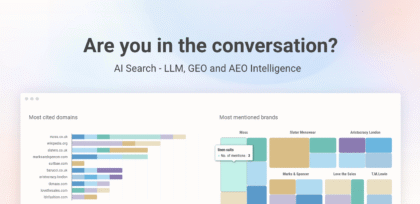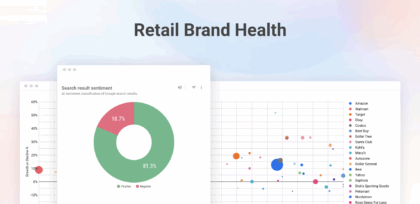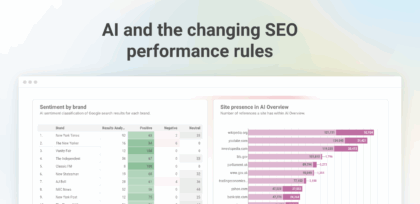SEO for LLMs: How to Build Brand Visibility in Generative Engines
03 Jun 2025|5 MIN READ
This seems to be the biggest question on everybody's mind right now: what do we mean by generative engines? And more importantly, what does it mean for marketers, content creators, and SEO professionals?
This is not just about future-proofing but about adapting to a present reality that is already changing audience behaviour and how content gets discovered. AI overviews are disrupting traditional marketing metrics. Click-through rates are down, search volume is down, and cost per click is higher than ever. At the same time, visibility into mid-funnel research and comparison queries is being hidden by these AI overviews.
So how do we figure out what conversations people are having?
Visibility is going to be more important than ever as a measure of performance, especially given the absence of click data. We are moving from asking “what keyword should I optimise for?” to “what questions should I answer?” and ultimately, “what conversations do I need to be part of?”
This is not a complete departure from traditional SEO. It is an evolution, an expansion. The old tactics are not gone, but they are not enough on their own. We need a nuanced strategy that acknowledges both the disruptive potential of LLMs and the new opportunities they present for audience engagement and information delivery.
Understand how conversations in LLMs result in often very different journeys and outcomes
The shift is already underway. Between October 2023 and January 2024, ChatGPT’s traffic volume reportedly surpassed that of Bing, and forecasts suggest LLMs could capture as much as 15% of the search market by 2028. Gartner is projecting a 25% decline in traditional search engine volume by 2026, with potential organic traffic losses of up to 50% for brands over the following three years.
People are spending much more time in generative environments like ChatGPT, Perplexity, and Google’s AI overview compared to traditional search. We’re seeing six and a half minutes in ChatGPT, over twelve minutes in Perplexity, compared to less than two minutes in Google Classic. It makes sense because these aren’t just quick searches. They are ongoing, nuanced conversations.
If we are still focusing only on click-throughs and rankings, we are missing the point. AI overviews and multi-turn dialogues are concealing mid-funnel feedback. We can’t see the research and comparison stages anymore, but we know they are happening. The real question is: are we part of those conversations? If not, we are invisible.
Visibility is becoming the new north star for SEO. Without the click data we used to rely on, visibility—how often, where, and how our brand shows up in these conversations—becomes critical.
The core differences between traditional SEO and SEO for LLMs, and why the old rules aren’t enough anymore
This is not about discarding everything we know but about recognising that the game has changed. Think of it as an expansion of traditional SEO. The foundations remain relevant, but we need to broaden our approach.
LLMs interpret content through a different lens than traditional search crawlers. They do not just scan pages for keywords; they ingest information, break it into tokens, and evaluate the semantic relationships between words, concepts, and context. It is no longer just about creating a perfect snippet but about how the AI understands and represents our brand.
LLMs pull from the entire digital footprint. Social media, PR, industry mentions—all of it contributes to the authority ecosystem. It is not enough to focus on keyword density or backlinks. The task is to build a consistent, accurate, and authoritative presence that models can recognise and reward.
Key differences include:
- Primary goal: From ranking and click-throughs to influencing how LLMs interpret, synthesise, and present brand information in direct answers.
- Content presentation: From optimising for snippets to ensuring our content is accurately summarised or synthesised, often without direct citations.
- Keywords vs. concepts: Moving from specific keywords to broader themes, semantic relevance, and entity-based optimisation.
- Scope of optimisation: From focusing on one website to optimising the entire digital footprint—social media, PR, third-party platforms, and authoritative databases.

Traditional SEO vs. LLM Optimisation: Understanding the new rules of engagement in the evolving search landscape
Each model (ChatGPT, Perplexity, Gemini, Claude) has its nuances. Some lean heavily on sources like Wikipedia and Reddit; others prioritise news outlets and real-time data. Covering all bases with high-quality, consistent content is essential.
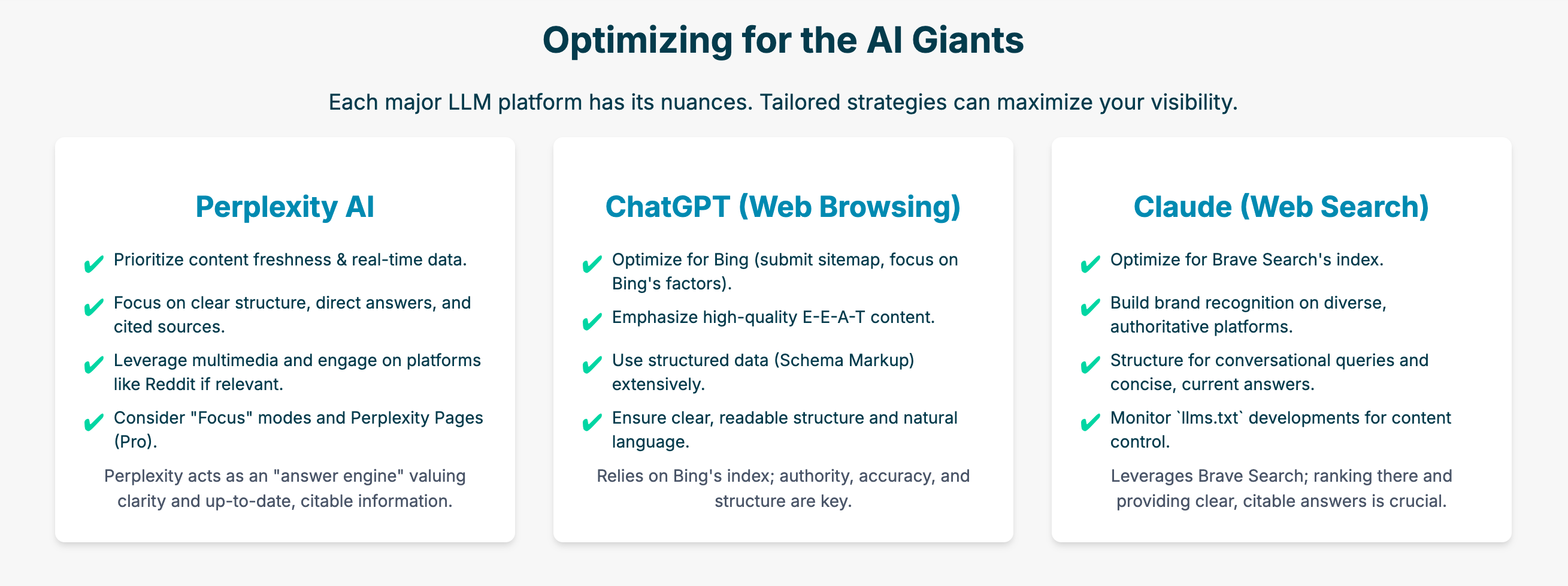
Understanding the unique behaviours of ChatGPT, Perplexity, Gemini and Claude is essential
Practical strategies to build authority, get cited by LLMs, and optimize your content for AI-driven discovery
If we are not actively working to be part of these conversations, we are already falling behind. Natural language and conversational content are the new standard. We need to go beyond static queries and create content that fits into multi-turn dialogue.
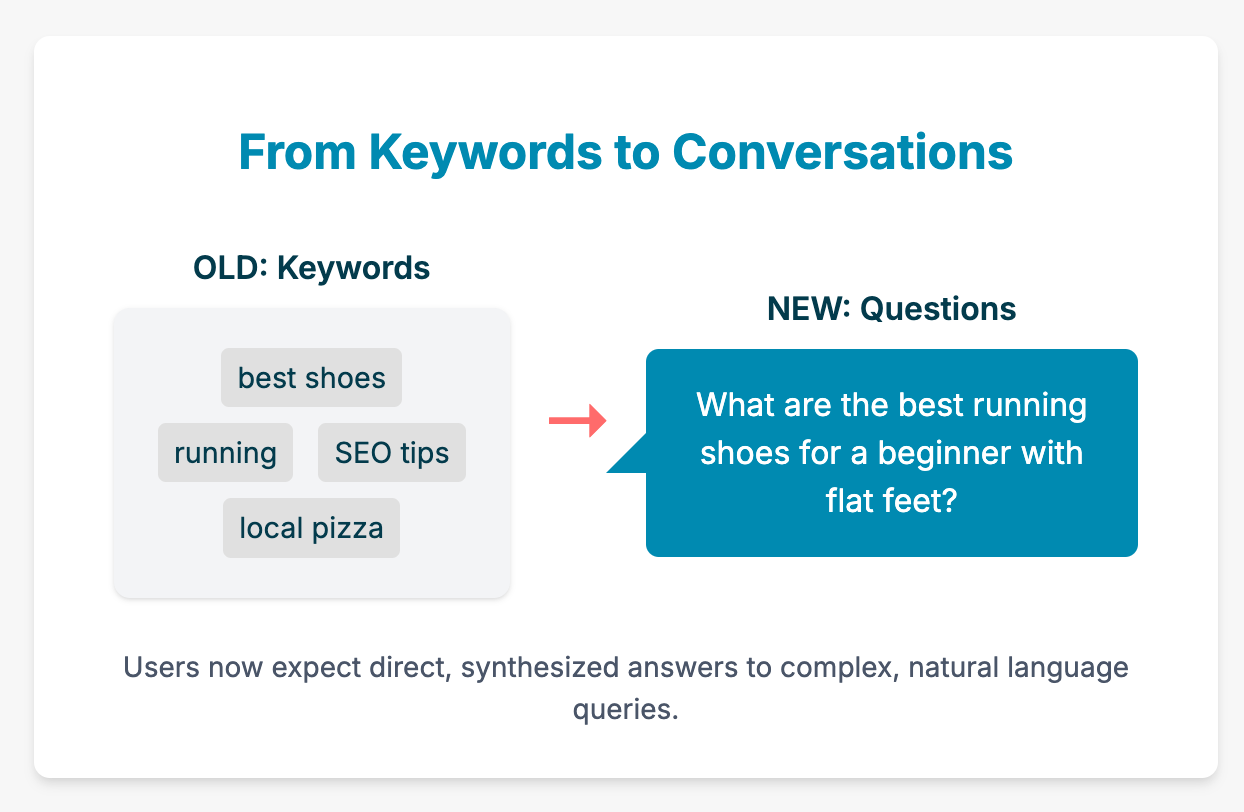
The shift from static keywords to dynamic, multi-turn conversational queries is redefining the SEO playbook
Quality and authority are non-negotiable. E-E-A-T: experience, expertise, authority, and trust—must underpin every piece of content. Structured data and semantic SEO are essential. If you haven’t implemented structured data yet, it is not too late; you can add it through Tag Manager or other methods.
Test where you already appear in AI-generated content. Use Google’s AI overview, ChatGPT, and Perplexity to see who’s getting cited, what types of content are winning, and where the gaps are. Build content that fills those gaps.
Being present on authoritative platforms like Wikipedia, Quora, Reddit, and respected industry publications is critical. These sources carry significant weight in how LLMs interpret authority. Video and social content also play a vital role. Google is incorporating creator content into the SERP, and we need to be there.
Key strategies include:
- E-E-A-T (Experience, Expertise, Authority, Trust): Essential for credibility in AI-generated responses. Content must be trusted, authoritative, and high-quality.
- Semantic SEO and structured data: Use schema markup and clear, structured formats (tables, Q&A, lists) to help LLMs interpret content accurately.
- Leverage authoritative platforms: Secure and maintain visibility on Wikipedia, Quora, Reddit, and respected media outlets. Genuine contributions to these ecosystems boost authority.
- Optimise for Knowledge Graphs: Enhance your presence in relevant graphs to improve visibility and reduce misinformation risks.
- Responsive, fresh content: Regularly update and expand content to stay relevant, as LLMs favour up-to-date, trustworthy information.
- Optimise content structure and format: Use clear headings, logical hierarchies, semantic richness, and concise paragraphs. Prioritise natural, conversational language.
How to audit your brand’s current presence for conversational search – and close visibility gaps
This is where Pi Datametrics is starting to make a real impact. You cannot guess your way into visibility. You need to track, analyse, and act.
With Pi, you can now move beyond manual sampling to systematically track your brand’s visibility in Google’s AI Overview (AIO). One example is Pi’s AIO Visibility Index, which focuses on YMYL content around topics like protein supplements, a category full of consumer interest and conversation. Out of 19 tracked features, we can isolate brand presence within the AI overview to see exactly who is leading the conversation on any given day. In this example, Men’s Health emerges as the clear leader, while other competitors need to step up to enter the conversation.
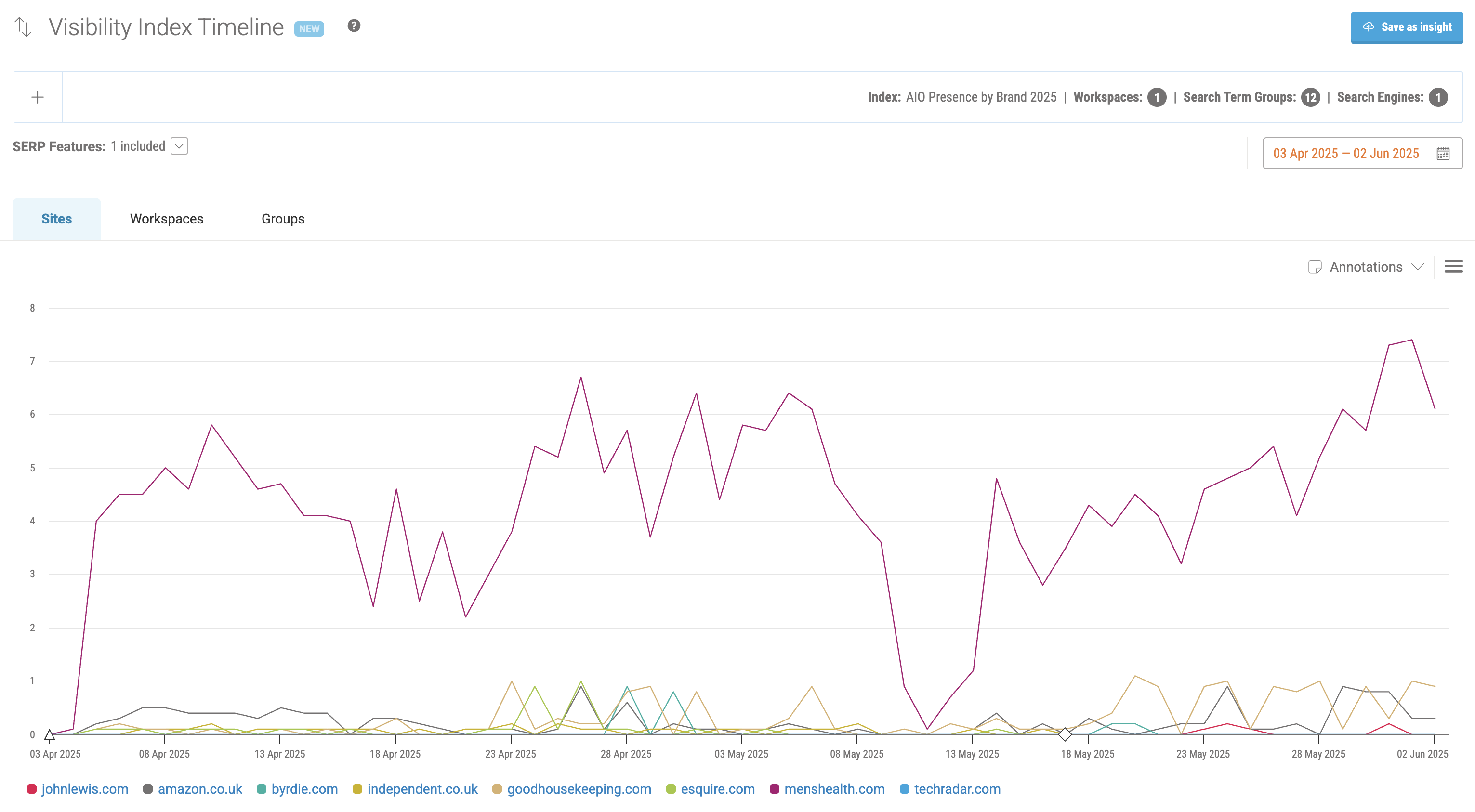
Image source: Pi’s AIO Visibility Index – Google Learn how to track AI Overviews in Pi Datametrics: AIO Tracking Solution for Enterprise SEO
But Google’s AI Overview is only part of the story. Pi Datametrics is also testing LLM tracking capabilities for ChatGPT and Perplexity. In the example below we anaylsed over 150 ChatGPT conversations to uncover brand presence trends over time. It’s no surprise that Wikipedia sits at the top here, an established, trusted authority source. From this data, we can drill down to see not just which brands are being mentioned, but who is mentioning them, and in what context.
Beyond Google – LLM (ChatGPT) tracking
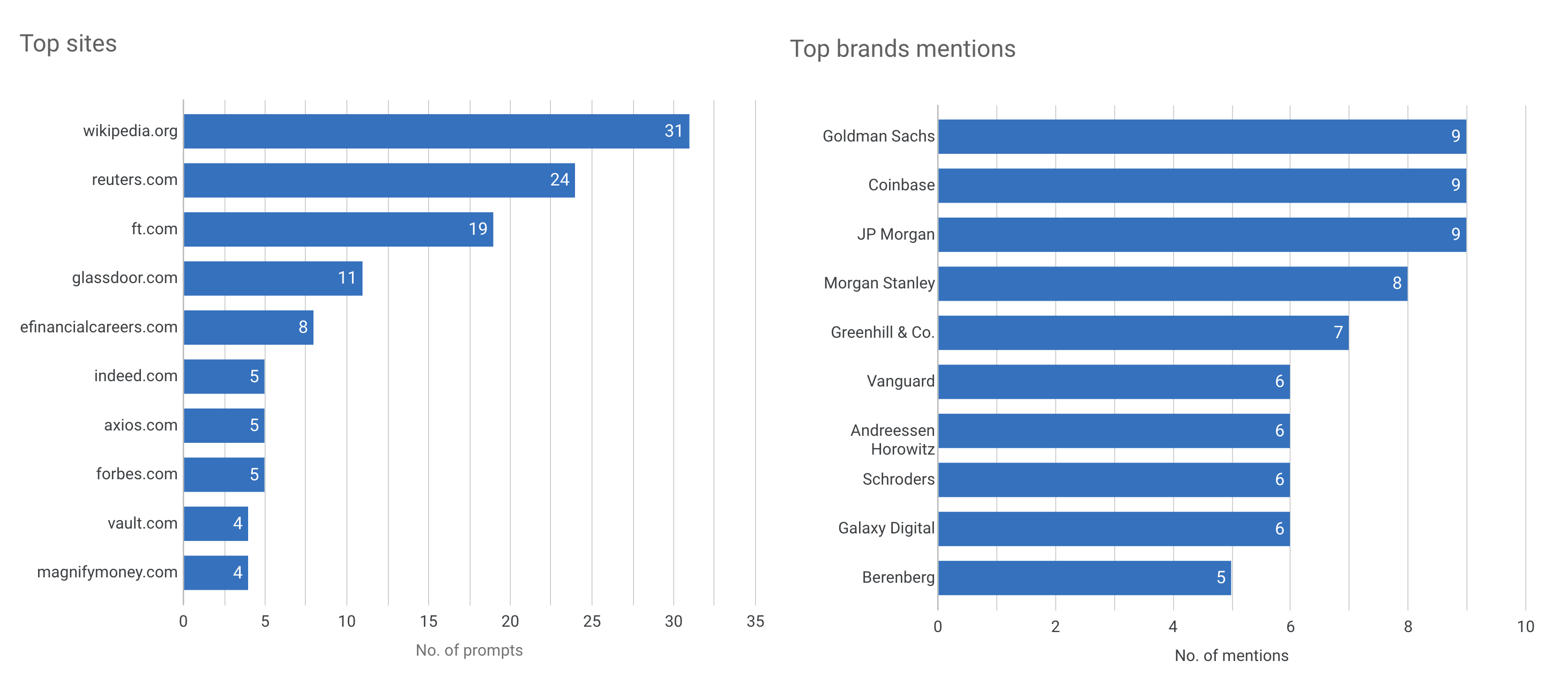 Image source: Pi’s LLM Tracking
Image source: Pi’s LLM Tracking
These features are currently in beta testing and will soon be available in the Pi app, giving brands a powerful tool to monitor, analyse, and act on their visibility in the evolving search landscape.
This isn’t about waiting for the algorithm to notice you. It’s about stepping up, understanding what’s happening in these conversations, and actively shaping your brand’s role within them.
Watch the webinar recording and download the slides
Missed the live session? Catch up on Jon Earnshaw’s insights and practical strategies for thriving in the age of generative AI. Plus, download the slides for future reference.
Ready to turn conversational AI into a competitive edge?
Request a demoNever miss a post
Join our mailing list and have our SEO news delivered straight to your inbox.

